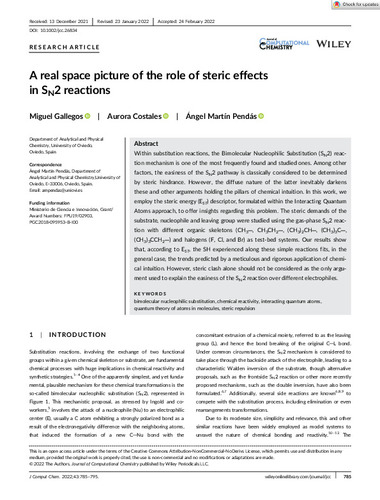A real space picture of the role of steric effectsin SN2 reactions
Autor(es) y otros:
Palabra(s) clave:
bimolecular nucleophilic substitution
chemical reactivity
interacting quantum atoms
Fecha de publicación:
Versión del editor:
Citación:
Descripción física:
Resumen:
Within substitution reactions, the Bimolecular Nucleophilic Substitution (SN 2) reaction mechanism is one of the most frequently found and studied ones. Among other factors, the easiness of the S N2 pathway is classically considered to be determined by steric hindrance. However, the diffuse nature of the latter inevitably darkens these and other arguments holding the pillars of chemical intuition. In this work, we employ the steric energy (EST) descriptor, formulated within the Interacting Quantum Atoms approach, to offer insights regarding this problem. The steric demands of the substrate, nucleophile and leaving group were studied using the gas-phase S N 2 reaction with different organic skeletons (CH3 , CH3 CH2, (CH 3)2 CH, (CH3 )3C, (CH3 )3CCH2 ) and halogens (F,Cl, and Br) as test-bed systems. Our results show that, according to EST, the SH experienced along these simple reactions fits, in the general case, the trends predicted by a meticulous and rigorous application of chemical intuition. However, steric clash alone should not be considered as the only argument used to explain the easiness of the S N 2 reaction over different electrophiles.
Within substitution reactions, the Bimolecular Nucleophilic Substitution (SN 2) reaction mechanism is one of the most frequently found and studied ones. Among other factors, the easiness of the S N2 pathway is classically considered to be determined by steric hindrance. However, the diffuse nature of the latter inevitably darkens these and other arguments holding the pillars of chemical intuition. In this work, we employ the steric energy (EST) descriptor, formulated within the Interacting Quantum Atoms approach, to offer insights regarding this problem. The steric demands of the substrate, nucleophile and leaving group were studied using the gas-phase S N 2 reaction with different organic skeletons (CH3 , CH3 CH2, (CH 3)2 CH, (CH3 )3C, (CH3 )3CCH2 ) and halogens (F,Cl, and Br) as test-bed systems. Our results show that, according to EST, the SH experienced along these simple reactions fits, in the general case, the trends predicted by a meticulous and rigorous application of chemical intuition. However, steric clash alone should not be considered as the only argument used to explain the easiness of the S N 2 reaction over different electrophiles.
ISSN:
DOI:
Notas Locales:
OA ATUO22
Patrocinado por:
We thank the Spanish MICINN, grant PGC2018-095953-B-I00, for financial support, M.G specially thanks the Spanish MICIU and MIU for the predoctoral FPU grant, FPU19/02903.
Colecciones
- Artículos [37532]
- Investigaciones y Documentos OpenAIRE [8366]
- Química Física y Analítica [635]
Ficheros en el ítem





